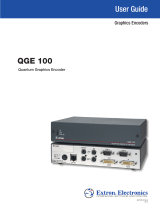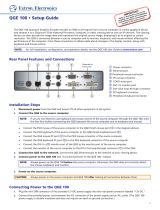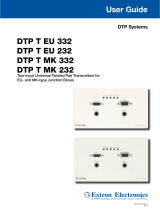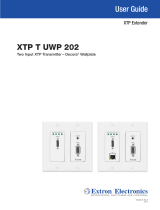Page is loading ...

1
QC 101 Controller • Setup Guide
This setup guide provides basic instructions for an
experienced user to install the QC 101 Controller. For
additional information and detailed procedures, see
the Quantum User Guide and the Quantum Control
Software User Guide, available at www.extron.com.
The Extron QC 101 E and QC 101 C are dedicated
controllers for the Quantum
®
Elite and Quantum
Connect videowall processors. They feature an
embedded operating system and the Quantum Control
Software preinstalled on the internal drive. The QC 101
provides an alternative to a traditional PC to program
congurations and control the Quantum processors.
ATTENTION:
• All structural steps and electrical installation must be performed by qualified personnel in accordance with local and
national building codes and electrical codes.
• Toute étape structurelle et installation électrique, doit être effectuée par un personnel qualifié, conformément aux
codes du bâtiment, aux codes incendie et sécurité, et aux codes électriques, locaux et nationaux.
NOTE: For full installation, configuration, and operation details, see the Quantum User Guide, which is provided with the
Quantum on the Extron Videowall Processing disc and is also available at www.extron.com.
Rear Panel Features and Connections
G
A
A
A
A
A
100-240V ~ 0.5A MAX
50-60Hz
DISPLAYPORT
1
AB
RGBHV
RS-232
Tx Rx G
RESET
2
1
2
HDMI
OUTPUTS
USB
LAN
OUTPUTS
REMOTE
B
CD
EF
H
3
POWER
Figure 1. QC 101 Rear Panel
A
AC power connector — Connect to an AC power
source.
B
DisplayPort output connector — (Optional)
C
USB connectors — Connect to a mouse, keyboard,
or flash drive. Connector 1 (top) accepts USB 2.0
signals and connector 2 accepts USB 3.0.
D
A and B LAN ports — Connect to a network or the
Quantum processor. These two RJ-45 connectors
support 10/100/1000 Base-T.
E
RGBHV output connector — (Optional) 15-pin VGA
F
Remote RS-232 connector — Connect to a control
system for RS-232 communication.
G
Power button — Using a small screwdriver or stylus,
press this recessed button momentarily to safely shut
down the controller. Pressing and holding the button for
4 seconds forces a hard shutdown of the QC 101.
H
HDMI output connector — (Optional)
NOTE: The button and LED labeled RESET are not functional.
Installation Steps
1. Disconnect power from all equipment.
2. (Optional) Mount the unit to a rack or furniture, following the instructions provided with the mounting hardware. Rack
and furniture mounting kits are available at www.extron.com.
3. Connect a display to the DisplayPort, VGA, or HDMI output connector (see figure 1,
B
,
E
, or
H
).
1
Preliminary

QC 101 • Setup Guide (Continued)
2
4. Connect the keyboard, mouse, and flash drive (if needed) to the rear panel USB ports (see figure 1,
C
, on the previous
page) to create and save Quantum Elite or Connect configuration project files (see the Quantum Control Software User
Guide, available at www.extron.com).
5. Connect a straight-through Ethernet cable between QC 101 LAN port A or B (
D
) and the network or the Control
connector on the rear panel of the Quantum chassis. If connecting through a LAN, ensure that the QC 101 is on the same
subnet as the Quantum processor or processors.
6. Connect a control device (such as an Extron IPCP or IPL Pro) to the Remote RS-232 port (
F
) for remote
control of the Quantum system using R-type commands (see the Quantum Control Software User Guide, available at
www.extron.com, for more about these commands).
7. Connect AC power to the QC 101 rear panel IEC connector (
A
). Connect power to all other devices in the system.
8. Power on the Quantum chassis and all other connected devices.
100-240V ~ --A MAX
50/60 Hz
OUTPUTS
OUTPUTS
REMOTE
USB LAN
DISPLAYPORT
1
3
AB RGBHV
RS232
Tx Rx G
RESET POWER
2
HDMI
Control
VLAN
Ethernet
Ethernet
Ethernet
RS-232
HDMI
HDMI
HDMI
USBUSB
Mouse
Display
Keyboard
HDMI
Extron
Quantum Connect
HDCP-Compliant Videowall
Processing System
Ext
ron IPCP Pro 250
IP Link Pro Control Processor
Extron
QC 101 C
Controller for
Quantum Connect
QUANTUM CONNECT 408
VIDEO WALL PROCESSOR
DATA
1000
LINK
ACT
R
IR
IPCP PRO 250
eBUS
OVER
LIMIT
S
COM
I/O
1
2
2
4
1
321
RTS
CTS
Tx
Rx
RELAYS
IR/S
Sources
Displays
Figure 2. QC 101 Connection Example with a Quantum Connect
NOTE: The QC 101 front panel has no controls that are involved in setup. It contains four indicator LEDs that provide status
for power and booting (Power), disk drive activity (SSD), and network activity (LAN A and LAN B). The USB Config port is
reserved for future use.
Configuring the QC 101
After all rear panel connections have been made and all connected devices are powered on, you are ready to congure the
QC 101 to manage the Quantum processors. To do this, set the IP address of the QC 101, then either create a project le using
the Quantum Control Software (loaded on the QC 101 prior to delivery) or upload an existing project le that was congured using
a computer.
Setting the IP Address of the QC 101
The QC 101 controller is a host device with an embedded operating system. To communicate with the Quantum processor, the
QC 101 must be on the same network and subnet as all the Quantum processors in the system. To set the QC 101 IP address,
you need a keyboard and mouse connected to one or both of the USB ports and a monitor connected to one of the output ports.
1. Do either of the following:
z On the QC 101 Start screen, click the Network Connections icon (shown at right), or
z On the desktop screen, double-click the Network Connections shortcut icon on the desktop.
The Network Connections window opens.
2

3
2. Right-click the name of the LAN port in use (highlighted and no red X) and select Properties from the pop-up menu.
Figure 3. Selecting a LAN Port
3. On the LAN Properties window, scroll to locate and select the
Internet Protocol Version 4 (TCP/IPv4) checkbox (see
1
in
the illustration at right), and click Properties (
2
).
4. In the Internet Protocol Version 4 (TCP/IPv4) Properties
window, enter the desired QC 101 IP address parameters and click
OK. The IP address must be on the same subnet as those of the
Quantum processors.
5. In the QC 101 Shell window (which opened at the same time as the
Network Connections window in step 1), click the Commit C Drive
button (see figure 4,
1
).
Figure 4. Click Commit C Drive on the QC 101 Shell Window
6. On the confirmation prompt that opens, click OK to save the address changes to the hard drive and reboot the controller. A
password prompt opens. Enter the password (the default password is extron) where indicated on the prompt and click OK.
NOTE: The factory configured passwords for all accounts on this device have been set to the device serial number. In
the event of an absolute system reset, the passwords convert to the default, which is no password.
ATTENTION:
• Do not power off or reset the QC 101 while it is rebooting.
• Veuillez ne pas éteindre ni réinitialiser le QC 101 lors du redémarrage.
Setting Up the Quantum Control Software
To use the Quantum software to congure and control the processor, start by setting up a project (presentation), in which you
dene the processor, select or create a layout, set up video sources, and create multiple scenes.
NOTE: The C: drive on the QC 101 is write-protected. Therefore, files located on the C: drive that are created or changed are
not saved when power is cycled to the QC 101. Save any new or changed projects on the controller to the QC 101 internal
D: drive or to a flash drive attached to one of the USB ports on the QC 101 rear panel.
1. Create a new project or upload an existing one.
z If creating a new project, see the Quantum Control Software User Guide for detailed instructions. Save the project to
the QC 101 D: drive and double-click its filename to open the project.
z If uploading an existing project that was created on a PC, copy the project file directly to the QC 101 D: drive and
double-click its filename to open the project.
3
4

68-2882-50
Rev. B 12 19
© 2016-2020 Extron Electronics — All rights reserved. www.extron.com
All trademarks mentioned are the property of their respective owners.
Worldwide Headquarters: Extron USA West, 1025 E. Ball Road, Anaheim, CA 92805, 800.633.9876
4
For information on safety guidelines, regulatory compliances, EMI/EMF compatibility, accessibility, and related topics, see the
Extron Safety and Regulatory Compliance Guide on the Extron website.
2. Test presets and input switching within the Quantum Software to ensure that the project is satisfactory.
3. Set up the RS-232 connection to the control system as follows:
a. In the Quantum Control Software window, click Communications Setup on the left Taskbar panel.
b. On the Communications Setup screen, select COM1 in the Devices panel (see figure 5,
1
).
c. In the Port Settings panel (
2
), enter the settings required by the control system being used.
d. In the Serial Commands panel (
3
), select the Input and Output checkboxes to make the RS-232 connection
bidirectional. This allows for commands be sent and received.
Figure 5. Configuring RS-232 Communication
4. Re-save the project file to the D: drive and close the Quantum software.
5. In the QC 101 Shell window, click Commit C Drive to save the software settings to the C: drive and to reboot the QC 101.
Confirm that the project file was loaded and connected to the Quantum processors automatically after the reboot.
R-Type Commands
R-Type commands are serial data strings that the Quantum Control Software can receive via the RS-232 port. They can consist of
ASCII text, hexadecimal data, and control characters. The following table lists some commonly used R-Type commands.
Command ASCII-Hexadecimal Description
Recall Scene
Recall by list position
[01] R
X!
[02] 05 [17] [03] Recall scene number
X!
according to the
scene list.
Recall by scene name
[01] R
X@
[02] 07 [17] [03] Recall the scene named
X@
.
Recall next scene
[01] R [02] 0n [17] [03]
Recall the next scene in the list.
Recall previous scene
[01] R [02] 0p [17] [03]
Recall the previous scene in the list.
Window Source
Select input
[01] R
X#
X1!
[02] 36 [17] [03] Select input
X1!
to be shown in window
X#
.
Window Visibility
Hide window
[01] R
X#
0 [02] 33 [17] [03] Set window
X#
to be hidden.
Example:
[01] R 00050 [02] 33 [17] [03]
Set window 6 to be hidden
Show window
[01]R
X#
1[02]33[17][03] Set window
X#
to be displayed.
5
/







